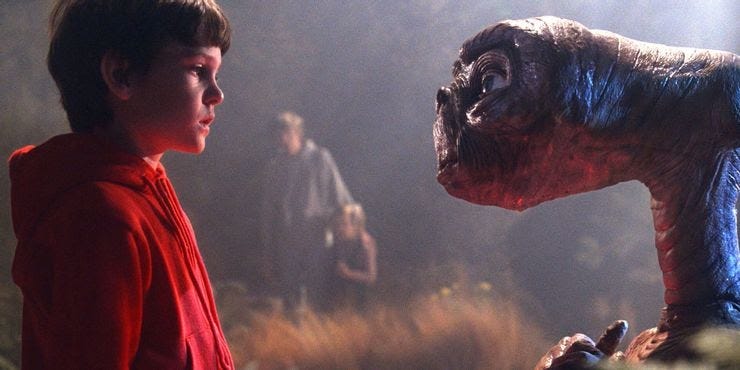General overview
Elliot and the others tumble into the forest on their bikes, crashing through the shrubbery. A tracking shot zooms in as Elliot clears debris from E.T.’s contraption. Suddenly, a beam of light floods the scene, drawing their attention skyward as the spaceship descends gracefully into the forest. E.T.’s heart lights up once more, signalling his reunion with his friends. Gertie interrupts the moment, shouting from a car window that they’ve found them. She rushes over to E.T. handing him the plant with a heartfelt goodbye. E.T. bids her to “be good” before receiving a small kiss from Gertie and a word of gratitude from Michael. Placing the plant on the ground, E.T. beckons Elliot to join him, but Elliot pleads for him to stay. With a heavy heart, E.T. traces a path from his glowing heart to his lips, signifying his own farewell. Tears streaming down his face, Elliot reciprocates the gesture as they embrace, with Elliot’s mother watching, overcome with emotion. The spaceship’s light frames them as they part, E.T. promising to always be with Elliot. With a final glance, E.T. boards the ship, his glowing heart fading into the darkness as the door closes. The last glimpse of him is through the glowing heart, leaving Elliot staring up at the sky in a close-up shot. The dramatic drumbeat of the score crescendos, and the scene fades to black.
Cinematography
Tracking shots follow Elliot’s movements as he clears debris from E.T.’s abandoned transmitter contraption. This not only underscores his significance as a character but also serves as a gentle reminder to the audience of where their attention should be directed.
The usage of tracking shots, the camera follows Elliot’s actions as he removes debris from E.T.’s former transmitter contraption. This not only highlights Elliot’s essential role in the narrative but also serves as a subtle cue to the audience, reinforcing where their focus should lie with the unfolding events.
The classical Hollywood filmmaking approach, known for its clarity in depicting conversations, is used to ensure the audience fully comprehends the farewell exchange between Elliot and E.T. This stylistic choice includes a progression from wide shots to tighter mid-shots, over-the-shoulder shots, and shot-reverse-shot sequences. By taking advantage of this style, the emotional tension of the scene is heightened, intensifying the drama of their parting.
Mise-en-scène
As a light illuminates Elliot’s face, the non-diegetic musical score swells, signalling the arrival of the spaceship. This cinematic cue enhances the audience’s comprehension of the narrative, increasing the understanding of this event.
The correlation between the radiant glow of E.T.’s heart and the vibrant red of Elliot’s jumper deepens their already strong connection, drawing them closer together. Elliot’s choice of bright primary colour stands out among the muted clothing of the other characters, emphasising his importance and capturing the audience’s focus.
As Elliot bids his farewells and embraces E.T, his mother sinks to her knees, her eyes welling up with tears. This moment signifies her ultimate realisation of E.T’s goodness. As she lowers herself to Elliot’s eye level, she begins to perceive the world from his perspective, gaining insight into how both Elliot and the audience perceive E.T.
Sound
The non-diegetic score from the previous scene fades away as the next sequence unfolds. As emotions surface, the score returns, acting as a tool to manipulate the audience’s feelings and prompt a sense of sadness.
During Elliot and E.T’s farewell, the score intensifies, becoming increasingly manipulative and guiding our emotions through the non-diegetic composition.
Editing
This sequence relies on continuity editing without any cross-cutting, transitions, or parallel editing techniques. This deliberate choice simplifies the scene, making it more accessible and straightforward for its targeted audience.
The farewell sequence uses a series of vignettes, with each character saying goodbye in succession: first Gertie, followed by Michael, and finally Elliot. As the scenes progress, they gradually increase in duration and emotional intensity, reaching its climax delivering the highest emotional intensity of the scene. This strategic arrangement heightens the significance and resonance of Elliot’s goodbye, increasing its impact on the audience.




